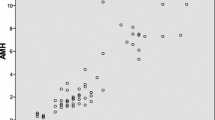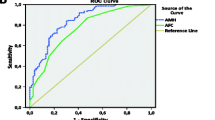Abstract
Purpose
To investigate whether serum anti-müllerian hormone (AMH), follicle stimulating hormone (FSH), or antral follicle count (AFC) are predictive for clinical pregnancy in in vitro fertilization (IVF) patients.
Methods
Serum AMH, inhibin B, FSH, luteinizing hormone (LH), estradiol (E2), prolactin, and thyroid stimulating hormone (TSH) levels and AFC of 189 women under 40 years of age were investigated. Pregnant and non-pregnant women were compared.
Results
Forty-seven (24.8 %) clinical pregnancies were observed in 189 women. There was no significant difference in terms of mean age, duration of infertility, body mass index, AMH, LH, FSH, E2, TSH, Inhibin B, AFC and total oocyte number between women who did and who did not become pregnant. Additionally, there was no significant difference in clinical pregnancy rates between the quartiles of AMH, FSH and AFC. (P values were 0.668, 0.071, and 0.252, respectively.)
Conclusion
Serum AMH and FSH, and AFC cannot predict clinical pregnancy in IVF patients under 40; the pregnancy rate tends to increase as AMH increases, although this remains non-significant.


Similar content being viewed by others
References
Majumder K, Gelbaya TA, Laing I, Nardo LG. The use of anti-Müllerian hormone and antral follicle count to predict the potential of oocytes and embryos. Eur J Obstet Gynecol Reprod Biol. 2010;150(2):166–70.
Borini A, Dal Prato L. (2005) Tailoring FSH and LH administration to individual patients. Reprod Biomed Online.;11:283–93.
Check JH, Peymer M, Lurie D. (1998) Effect of age on pregnancy outcome without assisted reproductive technology in women with elevated early follicular phase serum follicle-stimulating hormone levels. Gynecologic and Obstetric Investigation, 45, 217–220.
Faddy MJ, Gosden RG. (1995) A mathematical model of follicle dynamics in the human ovary. Human Reproduction,10, 770–775.
Scott RT, Toner JP, Muasher SJ Oehninger S, Robinson S, Rosenwaks Z.(1989) Follicle-stimulating hormone levels on cycle day 3 are predictive of in vitro fertilization outcome. Fertility and Sterility, 51, 651–654.
Toner JP, Philput CB, Jones GS, Muasher SJ. (1991) Basal follicle-stimulating hormone level is a better predictor of in vitro fertilization performance than age. Fertility and Sterility, 55, 784–791.
Seifer DB, Lambert-Messerlian G, Hogan J, Gardiner AC, Blazar AS, Berk CA. (1997) Day 3 serum inhibin-B is predictive of assisted reproductive technologies outcome. Fertility and Sterility, 67, 110–114
Lekamge DN, Barry M, Kolo M, Lane M, Gilchrist RB, Tremellen KP. (2007) Anti-Müllerian hormone as a predictor of IVF outcome. Reprod Biomed Online.;14(5):602–10
Josso N. (2008) Professor Alfred Jost: the builder of modern sex differentiation. Sex Dev.;2(2):55–63. Epub 2008 Jun 20.
Durlinger AL, Visser JA, Themmen AP. (2002) Regulation of ovarian function: The role of anti-müllerian hormone. Reproduction.;124:601–9
La Marca A, Broekmans FJ, Volpe A, Fauser BC, Macklon N. (2009), ESHRE Special Interest Group for Reproductive Endocrinology–AMH Round Table: Anti-Mullerian hormone (AMH): what do we still need to know? Hum Reprod, 24:2264–2275.
Durlinger ALL, Gruijters MJG, Kramer P, Karels B, Kumar TR, Matzuk MM, Rose UM, de Jong FH, Uilenbroek JT, Grootegoed JA, Themmen AP. (2001) Anti-mullerian hormone attenuates the effect of FSH on follicle development in the mouse ovary. Endocrinology;142:4891–9.
Weenen C, Laven JSE, von Bergh ARM, Cranfield M, Groome NP, Visser JA, Kramer P, Fauser BC, Themmen AP. (2004) Anti-mullerian hormone expression pattern in the human ovary: potential implications for initial and cyclic follicle recruitment. Mol Hum Reprod;10:77–83.
Baarends WM, Uilenbroek JT, Kramer P, Hoogerbrugge JW, van Leeuwen EC, Themmen AP, Grootegoed JA. (1995) Anti-mullerian hormone and anti-mullerian hormone type 2 receptor messenger ribonucleic acid expressions in rat ovaries during postnatal development, the estrous cycle and gonadotropin-induced follicle growth. Endocrinology;136:4951–62.
Sahmay S, Guralp O, Senturk LM, Imamoglu M, Kucuk M, Irez T. Serum anti-mullerian hormone concentrations in reproductive age women with and without polycystic ovary syndrome: the influence of body mass index. Japan Society for Reproductive Medicine. 2011.
Ebner T, Sommergruber M, Moser M, Shebl O, Schreier-Lechner E, Tews G. (2006) Basal level of anti-mullerian hormone is associated with oocyte quality in stimulated cycles. Hum Reprod;21:2022–6.
Fong SL, Baart EB, Martini E Schipper I, Visser JA, Themmen AP, de Jong FH, Fauser BJ, Laven JS. (2008) Anti-mullerian hormone: a marker for oocyte quantity, oocyte quality and embryo quality. Reprod Biomed Online;16: 664–70.
Irez T, Ocal P, Guralp O, Cetin M, Aydogan B, Sahmay S. Different serum anti-Müllerian hormone concentrations are associated with oocyte quality, embryo development parameters and IVF-ICSI outcomes. Arch Gynecol Obstet. 2011;284(5):1295–301.
Eldar-Geva T, Ben-Chetrit A, Spitz IM, Rabinowitz R, Markowitz E, Mimoni T, Gal M, Zylber-Haran E, Margalioth EJ. (2005) Dynamic assays of inhibin B, anti-Mullerian hormone and estradiol following FSH stimulation and ovarian ultrasonography as predictors of IVF outcome. Hum Reprod.;20(11):3178–83.
Elgindy EA, El-Haieg DO, El-Sebaey A. (2008) Anti-Müllerian hormone: correlation of early follicular, ovulatory and midluteal levels with ovarian response and cycle outcome in intracytoplasmic sperm injection patients. Fertil Steril.;89(6):1670–6.
Hazout A, Bouchard P, Seifer DB, Aussage P, Junca AM, Cohen-Bacrie P. (2004) Serum antimüllerian hormone/müllerian-inhibiting substance appears to be a more discriminatory marker of assisted reproductive technology outcome than follicle-stimulating hormone, inhibin B, or estradiol. Fertil Steril.;82(5):1323–9.
Nelson SM, Yates RW, Fleming R. (2007) Serum anti-mullerian hormone and FSH: Prediction of live birth and extremes of response in stimulated cycles–implications for individualization of therapy. Hum Reprod;22:2414–21.
Wu CH, Chen YC, Wu HH, Yang JG, Chang YJ, Tsai HD. (2009) Serum anti-Müllerian hormone predicts ovarian response and cycle outcome in IVF patients. J Assist Reprod Genet.; 26(7):383–9.
Deffieux X, Antoinne JM. (2003) Inhibins, activins and anti-Müllerian hormone: structure, signalling pathways, roles and predictive value in reproductive medicine. Gynecol Obstet Fertil;31(11):900–11
Penarrubia J, Fabregues F, Manau D, Creus M, Casals G, Casamitjana R, Carmona F, Vanrell JA, Balasch J. (2005) Basal and stimulation day 5 anti- Mullerian hormone serum concentrations as predictors of ovarian response and pregnancy in assisted reproductive technology cycles stimulated with gonadotropin-releasing hormone agonist-gonadotropin treatment. Hum Reprod;20:915–22.
Smeenk JMJ, Sweep FCGJ, Zielhuis GA, Kremer JAM, Thomas CMG, Braat DDM. (2007) Anti-mullerian hormone predicts ovarian responsiveness, but not embryo quality or pregnancy, after in vitro fertilization or intracytoplasmic sperm injection. Fertil Steril;1:223–6.
Tremellen K, Kolo M. (2010) Serum anti-Mullerian hormone is a useful measure of quantitative ovarian reserve but does not predict the chances of live-birth pregnancy. Aust N Z J Obstet Gynaecol.;50(6):568–72.
Fanchin R, Schonauer LM, Righini C, Guibourdenche J, Frydman R, Taieb J. (2003) Serum anti mullerian hormone is more strongly related to ovarian follicular status than serum inhibin B, estradiol, FSH and LH on day 3. Hum Reprod;18:323–7.
Takahashi C, Fujito A, Kazuka M, Sugiyama R, Ito H, Isaka K. (2008) Anti-Müllerian hormone substance from follicular fluid is positively associated with success in oocyte fertilization during in vitro fertilization. Fertil Steril.;89(3):586–91.
Wunder DM, Guibourdenche J, Birkhäuser MH, Bersinger NA. (2008) Anti-Müllerian hormone and inhibin B as predictors of pregnancy after treatment by in vitro fertilization/intracytoplasmic sperm injection. Fertil Steril.;90(6):2203–10.
Broer SL, Mol BW, Hendriks D, Broekmans FJ. (2009) The role of antimullerian hormone in prediction of outcome after IVF: comparison with the antral follicle count. Fertil Steril.;91(3):705–14.
Sahmay S, Cetin M, Ocal P, Kaleli S, Senol H, Birol F, Irez T. Serum anti-Müllerian hormone level as a predictor of poor ovarian response in IVF patients. Reprod Med Biol. 2011;10:9–14.
Ocal P, Sahmay S, Cetin M, Irez T, Guralp O, Cepni I. Serum anti-Müllerian hormone and antral follicle count as predictive markers of OHSS in ART cycles. J Assist Reprod Genet. 2011;28(12):1197–203.
Wang JG, Douglas NC, Nakhuda GS, Choi JM, Park SJ, Thornton MH, Guarnaccia MM, Sauer MV. The association between anti-Müllerian hormone and IVF pregnancy outcomes is influenced by age. Reprod Biomed Online. 2010 Dec;21(6):757–61.
Acknowledgements
We would like to thank Begum Aydogan MD, Nil Atakul, MD, Sarper Erdogan, PhD, Hulya Senol, Naciye Erol, Birsen Yıldız, Neslihan Bardak Gürel and Mutlu Tezel for their sincere support and technical assistance.
Conflict of interest
None.
Author information
Authors and Affiliations
Corresponding author
Additional information
Capsule
Serum AMH and FSH, and AFC cannot predict clinical pregnancy in IVF patients under 40; the pregnancy rate tends to increase as AMH increases, although this remains non-significant.
Rights and permissions
About this article
Cite this article
Sahmay, S., Demirayak, G., Guralp, O. et al. Serum Anti-müllerian hormone, follicle stimulating hormone and antral follicle count measurement cannot predict pregnancy rates in IVF/ICSI cycles. J Assist Reprod Genet 29, 589–595 (2012). https://doi.org/10.1007/s10815-012-9754-6
Received:
Accepted:
Published:
Issue Date:
DOI: https://doi.org/10.1007/s10815-012-9754-6




